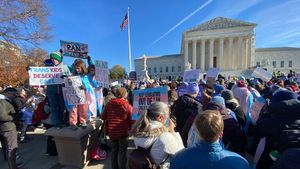Treatment GuideJust DiagnosedSex & DatingAfrican AmericanStigmaAsk the HIV DocPrEP En EspañolNewsVoicesPrint IssueVideoOut 100
CONTACTCAREER OPPORTUNITIESADVERTISE WITH USPRIVACY POLICYPRIVACY PREFERENCESTERMS OF USELEGAL NOTICE
© 2025 Pride Publishing Inc.
All Rights reserved
All Rights reserved
Scroll To Top
By continuing to use our site, you agree to our Privacy Policy and Terms of Use.
When AIDS researcher David Ho was named Time magazine's 1996 Man of the Year in an article heralding the arrival of protease inhibitors, there was'for a short time, at least'a belief that antiretroviral treatment could purge HIV from the body. And while stopping just short of using the word cure, AIDS patients, activists, and caregivers quietly hoped that the new anti-HIV drugs would rid HIV-positive people of their infections. 'With most viral infections, if you can inhibit the virus, you can eventually remove the treatment and you're cured,' says Eric Verdin, MD, an investigator at the University of California, San Francisco's Gladstone Institute of Virology. 'Initially, when people saw how effective antiretroviral therapy could be, there was a thought we could do this for HIV'that eventually we'd be able to remove the drugs and people would be cured.' But in one of the most disappointing setbacks of the two decades'plus course of the pandemic, scientists learned that the virus in patients who had successfully suppressed HIV replication, even for several years, inevitably came roaring back shortly after antiretroviral therapy was halted. Part of this is because certain regions of the body'referred to as viral reservoirs, including the brain, testes, and ovaries'are partially shielded from antiretroviral medications, says Charles Gonzalez, MD, an assistant professor of medicine at New York University. The immune system itself also is designed to work less efficiently in some of these bodily compartments. HIV-infected cells in these sanctuary sites can avoid the effects of antiretroviral therapy and quickly reseed the blood with the virus when anti-HIV drugs are stopped. Even the eyes, other parts of the central nervous system, and the epithelial cells of the kidneys could serve as long-term harbors for HIV. But most scientists consider the biggest viral reservoir'and likely the highest hurdle in eliminating HIV from the body'to be infected CD4 cells called 'memory T cells,' which serve as the foundation of the body's ability to fight off repeat infections. 'The whole basis of how the immune system works is that when you have an infection, specific lymphocytes recognize the invading microorganism and respond,' explains Robert Siliciano, MD, a professor of medicine at Johns Hopkins University. 'Some of these lymphocytes survive for years, and when you get the same infection again they get called back into action. But in the meantime, these lymphocytes are in a resting state.' This resting state, often called latency, is how HIV is able to essentially lie in hiding. Because the cells are dormant, they go unrecognized by both the immune system, which attacks and destroys active infected cells, and by anti-HIV drugs, which also target only active cells. Although the HIV inside memory cells is also dormant when the cell is turned off, it begins to make copies of itself as soon as the cell recognizes a specific invader and springs to life to fight it. A pool of HIV-infected memory cells begins to form almost immediately after infection and can be detected in some patients after only a few weeks, possibly in as little as 48 hours. Fortunately, the reservoir of latently infected CD4 memory cells is widely considered to be relatively small, consisting of only about 1 million cells out of trillions of CD4 cells. But memory T cells can live for decades in the body. This is fortunate, Gonzalez points out, because it means these cells stay primed to combat invading pathogens, sometimes for a lifetime. 'That's why if you get a measles vaccine or have measles once, you don't get it again,' he says. But for HIVpositive patients harboring virus in their memory cells, it also means it could take many years for the cells to die off, during which time highly active antiretroviral therapy would have to be consistently maintained. According to Susan Cu-Uvin, MD, director of the Immunology Center at the Miriam Hospital/Brown University in Providence, R.I., mathematical models show that even assuming there is a reservoir consisting of only 1 million cells, it would take 73 years to completely eradicate it. 'That's why there's no current cure for HIV,' she says, 'even with HAART.' But promising research under way at several major AIDS centers aims to at least partially'and, ideally, completely'drain these reservoirs. One approach is to activate latently infected cells so that the immune system will eventually detect and destroy them. Initial attempts to accomplish this using such proteins as interleukin-2 proved disastrous, Gonzalez says, because the compound activated all resting CD4 cells, providing easy targets for infection by the new viral copies being churned out by the activated latently infected calls. Activating all of the CD4 cells also can be toxic or even fatal, Siliciano says. Active immune system cells produce protein by-products called cytokines. These can be poisonous at high levels. 'A best example of this is toxic shock syndrome, which is caused by a bacterial toxin that activates only about 10% of T cells,' he explains. 'To induce global activation would release so many cytokines that the toxicity would be overwhelming.' To avoid that potentially deadly complication, Jerome Zack, MD, and other researchers at the University of California, Los Angeles, AIDS Institute have developed a method to only partially activate dormant immune system cells. The scientists first stimulated the cells with interleukin-7 and prostratin, a compound found in trees in Samoa, to produce key surface proteins that indicate the cells are HIVinfected. Then an engineered molecule containing an HIV antibody and a piece of diphtheria DNA recognizes the newly expressed proteins and binds to the cells. Once attached, the diphtheria toxin enters the cells and kills them. Uninfected CD4 cells are ignored by the antibody. 'It happens very quickly'before the cells can start making more virus,' Zack explains. In mouse studies, the research team was able to clear out 70% to 80% of the latently infected CD4 cells. Studies using monkeys are next up, Zack notes. Verdin's lab has tested compounds from a library of about 12,000 druglike molecules to see if any had an effect in activating latent cells, discovering that six of the compounds did so. 'Our goal wasn't to find a cure or medicine,' Verdin says, 'but to establish proof of principle that one can reactivate latent HIV in cells.' His team is writing a paper on their findings, which Verdin says may be used by a pharmaceutical company for possible new drug development. Researchers at the Georgetown University School of Medicine studying the synthetic molecule peptide-T, which is already being evaluated as a possible HIV fusion inhibitor, say that a nasal spray containing the molecule reduced the level of HIV-infected monocytes in 11 study volunteers. Follow-up studies are planned. Gonzalez says there is also preliminary work under way to partially activate and flush out the viral reservoir, then use a therapeutic vaccine to prime the immune system to adequately control the tiny amount of virus produced by the remaining infected memory cells. Even anti-HIV medications in the new fusion inhibitor and integrase inhibitor drug classes might be useful in protecting other CD4 cells from HIV infection or from churning out new viral copies after memory cells are reactivated, Gonzalez explains. This could result in a three-pronged attack: to activate the cells; use HAART to stop viral replication in them and prevent neighboring cells from becoming infected; and boost the immune system with a vaccine to clean up any virus left behind. Whether any of these or other approaches will be successful is a major point of contention among AIDS experts, pitting the more optimistic scientists against those who believe ridding the body of HIV will be impossible. And it is not just the long-term possibility of viral eradication that is in dispute. Precisely how HIV reservoirs work, if they consist only of resting CD4 cells, or even if they need to be entirely wiped out to prevent the reseeding of the body with virus also are matters of fierce debate. Siliciano believes an approach that only partially purges viral reservoirs is pointless: 'The virus can come back from a very low level very quickly. The only eradication that makes sense is 100%.' But Verdin suggests it may be possible for the immune system to control HIV infection if the viral level in the body, including in the reservoirs, is lowered to a certain threshold. 'In some viral infections,' he says, 'you don't have to have 100% eradication. Nobody knows at this point if only one viral particle is enough for infection or if it's 10 or 100.' But precisely what that threshold for HIV is'or if it exists at all'has not yet been determined. Other unanswered questions are whether dormant CD4 cells ever make copies of themselves, which would increase the size of the viral reservoir, or if HIV can infect resting cells, notes Hawazin Faruki, Ph.D., vice president of operations and director of strategic technology and development at LabCorp in North Carolina's Research Triangle Park. HIV uses two receptors on the surface of CD4 cells'CCR5 and CXCR4'to attach to and penetrate them. CCR5 receptors are typically masked on nonactive cells. But Faruki says some researchers have shown that the cells might exhibit tiny amounts of CCR5, just enough to allow HIV infection. Worse yet, she says, some HIV strains use only the CXCR4 receptor, which also would make resting cells an infection target. A further barrier to viral elimination is the fact that HIV does not infect only CD4 cells. The virus also has been shown to infect macrophages, immune system scavenger cells that engulf invading pathogens. And troubling findings from a French study have shown that fat cells, which have CCR5 surface receptors, could also be infected by HIV. 'A person has about a kilogram [two pounds] of lymphocytes,' says lead researcher France Pietri-Rouxel of the Cochin Institute in Paris. 'But someone like me has 15 kilograms [30 pounds] of fat. So fat cells could be the more important [reservoir] source.' Even ordinary HIV-infected cells that escape the effects of antiretroviral drugs in sanctuary sites could pose a problem in completely ridding the body of the virus, Gonzalez says. And discovering precisely where these cells lurk and how many reservoir cells exist is still outside the reach of routine diagnostic screenings, Faruki adds. The bottom line for HIV-positive people on successful antiretroviral therapy is to not expect to be able to abandon those pills anytime soon. Much still needs to be learned about HIV reservoirs in general and in understanding the size and scope of the role memory T cells play in these viral stockpiles before any treatment can be developed, Verdin says. Even a partially effective method for purging the viral reservoir is at least a decade away, he notes. Verdin also points out another reason to have some caution: 'If we eventually understand latency fully and deal with it completely, it might still not be enough'it might show us yet another problem, in the same way that HAART came along and people [had] thought it would be good enough. There very well might be other problems and limitations.' These hurdles, along with data from his lab's studies showing virtually no decay in the viral reservoirs of people on HAART for as long as seven years, are precisely why Siliciano says the best bet for HIV-positive people are stronger and less toxic antiretroviral drugs for a lifetime control of HIV infection. 'Developments in that are very rapid,' he points out, 'and that's going to be the hope for the immediate future.' But Verdin is not quite ready to accept that notion. 'I find that a very defeatist approach'to say we might as well throw our arms up in the sky and tell everyone with HIV to just take your medicine,' he says. 'Medical research is about dissecting problems until they're solved. There may be roadblocks and it may be extremely difficult to solve this problem, but my opinion is that we can't afford not to try.'
Recommended Stories for You
From our Sponsors
Most Popular
Lexi Love comes out as HIV+ after Trump deletes federal resources
January 23 2025 11:23 AM
Grindr is reminding us why jockstraps are so sexy and iconic
May 02 2025 5:36 PM
BREAKING NEWS: Trump admin moves to end federal HIV prevention programs
March 18 2025 6:10 PM
Trump's orders prompt CDC to erase HIV resources
January 31 2025 5:29 PM
Celebrating Black History Month with our annual African American issue
February 01 2025 3:28 PM
Tyler TerMeer vows to continue to fight for health care for all
January 28 2025 3:00 PM
Discover the power of Wellness in your life
March 26 2025 12:41 PM
Plus: Featured Video
More Videos
0 seconds of 1 minute, 58 secondsVolume 0%
Press shift question mark to access a list of keyboard shortcuts
Keyboard Shortcuts
Shortcuts Open/Close/ or ?
Play/PauseSPACE
Increase Volume↑
Decrease Volume↓
Seek Forward→
Seek Backward←
Captions On/Offc
Fullscreen/Exit Fullscreenf
Mute/Unmutem
Decrease Caption Size-
Increase Caption Size+ or =
Seek %0-9
Copied
Live
00:00
01:58
01:58
Latest Stories
Dancer. Healer. Survivor. DéShaun Armbrister is all of the above
July 02 2025 8:23 PM
Two right-wing Supreme Court justices signal they may uphold access to PrEP and more
April 21 2025 4:10 PM
Broadway's best raise over $1 million for LGBTQ+ and HIV causes
April 03 2025 7:15 PM
Plus nominated for 2025 GLAAD Media Award
January 22 2025 12:42 PM
'RuPaul's Drag Race' star Trinity K Bonet quietly comes out trans
December 15 2024 6:27 PM
AIDS Memorial Quilt displayed at White House for the first time
December 02 2024 1:21 PM
BREAKING: Supreme Court rules to save free access to preventive care, including PrEP
June 27 2025 10:32 AM
1985: the year the AIDS crisis finally broke through the silence
June 26 2025 11:24 AM
Trump admin guts $258 million in funding for HIV vaccine research
June 03 2025 3:47 PM
500,000 Children at Risk: PEPFAR Funding Crisis
April 08 2025 3:51 PM
The Talk Season 5 premieres this spring with HIV guidance for the newly diagnosed
March 26 2025 1:00 PM
Jess King is here to help you live your happiest, healthiest life yet
March 24 2025 4:35 PM
A camp for HIV-positive kids is for sale. Here's why its founder is celebrating
January 02 2025 12:21 PM
VIDEO: A man living with HIV discusses his journey to fatherhood
June 10 2025 4:58 PM
HRC holds 'die-in' to protest Trump health care cuts
April 28 2025 2:11 PM
Season 4 of The Switch on resilience & radical self-love returns this spring
March 26 2025 12:20 PM
Gerald Garth is keeping people of color happy and healthy through trying times
March 11 2025 3:38 PM
This long-term HIV survivor says testosterone therapy helped save his life.
December 16 2024 8:00 PM
Ricky Martin delivers showstopping performance for 2024 World AIDS Day
December 05 2024 12:08 PM


















































































